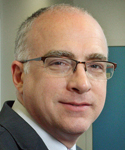 CHICAGO—Although medical treatments for addiction have been proved effective, they are not used often enough, said Kenneth Stoller, MD, during a session at the 2019 ACR State-of-the-Art Clinical Symposium, held April 5–7. These treatments bring health benefits that extend beyond addiction, he said.
CHICAGO—Although medical treatments for addiction have been proved effective, they are not used often enough, said Kenneth Stoller, MD, during a session at the 2019 ACR State-of-the-Art Clinical Symposium, held April 5–7. These treatments bring health benefits that extend beyond addiction, he said.
Dr. Stoller, assistant professor of psychiatry and behavioral sciences at Johns Hopkins University, Baltimore, said methadone, buprenorphine, naltrexone and other drugs to treat addiction are underused due to long-standing stigmas about drug use, as well as concerns about providing treatment without the support and guidance of addiction specialists. He said the medical community—including rheumatologists, whose patients require pain treatment and are susceptible to developing a use disorder—must ramp up treatment and referrals when appropriate, enabling patients to get the help they need.
“From your perspective, if you can get your patients to have their addiction treated, then this [treatment] will facilitate having [their] medical problems better addressed,” Dr. Stoller said. “This will improve medical adherence—not only [to the] medications you’re prescribing, but also [encourage patients to] come to appointments. Morbidity will decrease.” This can improve outcomes that are measures for value-based reimbursement.
He said, “[Opioid addiction] is a health crisis that was, at least in part, created and sustained by the medical system”—first by overprescribing opioids and, then, by sometimes decreasing opioids too precipitously. “Now, the medical system can effectively augment treatment by using these medications, [e.g., methadone, buprenorphine, naltrexone].”
The need for a better approach to addiction disorder certainly exists. In 2017, about 70,000 deaths from drug overdoses occurred, with over half opioids. And the use of, and deaths from, synthetic drugs, such as fentanyl—“the really scary stuff”—continues to increase, Dr. Stoller said.
Treatment Options
Three medications are available for treating alcohol use disorder. Disulfiram makes patients feel sick if they drink alcohol, preventing the body from getting rid of acetaldehyde and resulting in a need to monitor liver function. As with most medical treatments for addiction, adherence is a problem, Dr. Stoller said.
“Addiction is a disease that affects people’s ability to make choices that are not pro-drug,” he said. “So discontinuing one’s own disulfiram to allow for continued drinking is something we have to struggle against.”
Acamprosate has a less clear mechanism, but lowers the likelihood of drinking and has been used for a long time, particularly in Europe. But it has to be taken three times daily, and a patient “may not have the planning [ability] and executive functioning, especially early in recovery, to remember to take something three times per day.”
Naltrexone, an opioid antagonist, is used to decrease cravings in both alcohol use disorder and opioid use disorder. It also dampens the effects of opioids. When used to treat opioid use disorder, the patient needs to be completely opioid free before taking it, or naltrexone may cause withdrawal. The injectable form of naltrexone lasts 30 days and better enables adherence than the oral form. But it isn’t free of adherence concerns, because a patient may not show up for their next injection, Dr. Stoller acknowledged. Also, patients can still become impaired using alcohol, but it won’t feel good, he notes.
Methadone, for opioid use disorder, is a full-opioid agonist that—depending on the dose—treats withdrawal, reduces craving and blocks the effect of taking an opioid. It can only be given at one of the roughly 1,600 opioid treatment programs in the U.S.
Rheumatologists with patients in the hospital who are on methadone have to coordinate with these programs upon treatment admission, throughout the admission and especially upon discharge, because methadone cannot be prescribed by a discharging physician.
Methadone is the most highly regulated medication in medicine, Dr. Stoller said. Treatment programs have to provide services as supervised dosing, allowing patients to earn take-home doses; counseling; and drug testing; and assistance to meet other rehabilitation goals.
“The quality and quantity of services can vary across opioid treatment programs, so there may be some in your area that provide more comprehensive treatment that you’d want to direct patients to,” he said. Patients who use sedatives, such as benzodiazepines, can still be sedated, “so it’s important to pay attention to those abuse problems, as well.”
Although science has demonstrated good outcomes for patients taking methadone for decades, the drug still suffers from false perceptions. It’s often seen as a crutch or as substituting one drug for another, Dr. Stoller said.
He cautioned that patients on methadone get an analgesic effect for only a few hours and may still need pain medication. These patients may even need opioids after a substantial injury or post-surgically—and possibly a higher-than-normal dose due to cross-tolerance.
Dr. Stoller also cautioned against short-term treatment with methadone. “If somebody goes off of these medications within a year, there’s a very high likelihood of relapse,” he said. “The problem is, after you are off of these … agonist medications, the person is much more susceptible to overdose.”
Buprenorphine, another opioid use disorder treatment, is a partial agonist with a ceiling to its respiratory depressive effects, making it safer. Its formulation discourages diversion to illicit use by crushing pills. An analysis of data from Massachusetts found treating addition with buprenorphine or methadone led to lower monthly Medicaid costs, fewer relapses and a lower mortality rate, Dr. Stoller said.1
Dr. Stoller said all of these medications are underutilized, with buprenorphine the most studied in this regard. To dispense it, physicians need a waiver. “The studies all show the same thing,” he said. “The initial induction can be intimidating for people, because you can get precipitated withdrawal starting people on a partial agonist who are dependent on a full agonist. They’re also concerned about poor compliance with treatment and whether there are counseling treatments available.”
A Treatment Model
In Baltimore, Dr. Stoller is involved with an integrative approach called collaborative opioid prescribing, which encourages physicians to get waivers to prescribe buprenorphine. Comprehensive treatment in the program includes evaluation, induction and counseling. After they’re stabilized, patients are referred for medication to the program’s hubs, usually primary care physicians. During periods of instability for patients, counseling and urinalysis monitoring are increased, and the program can resume dosing medication when appropriate.
Dr. Stoller said this may be a model for a way forward.
“The thing I love about this model the most is that my patients are now motivated to go to their primary care provider appointments,” he said. “Because if they don’t, they’re not getting their prescription. And so they’re finally getting their chronic medical problems addressed.”
Thomas R. Collins is a freelance writer living in South Florida.
Reference
- Clark R, Samnaliev M, Baxter J, et al. The evidence doesn’t justify steps by state medicaid programs to restrict opioid addiction treatment with buprenorphine. Health Aff (Millwood). 2011 Aug;30(8):1425–1433.




